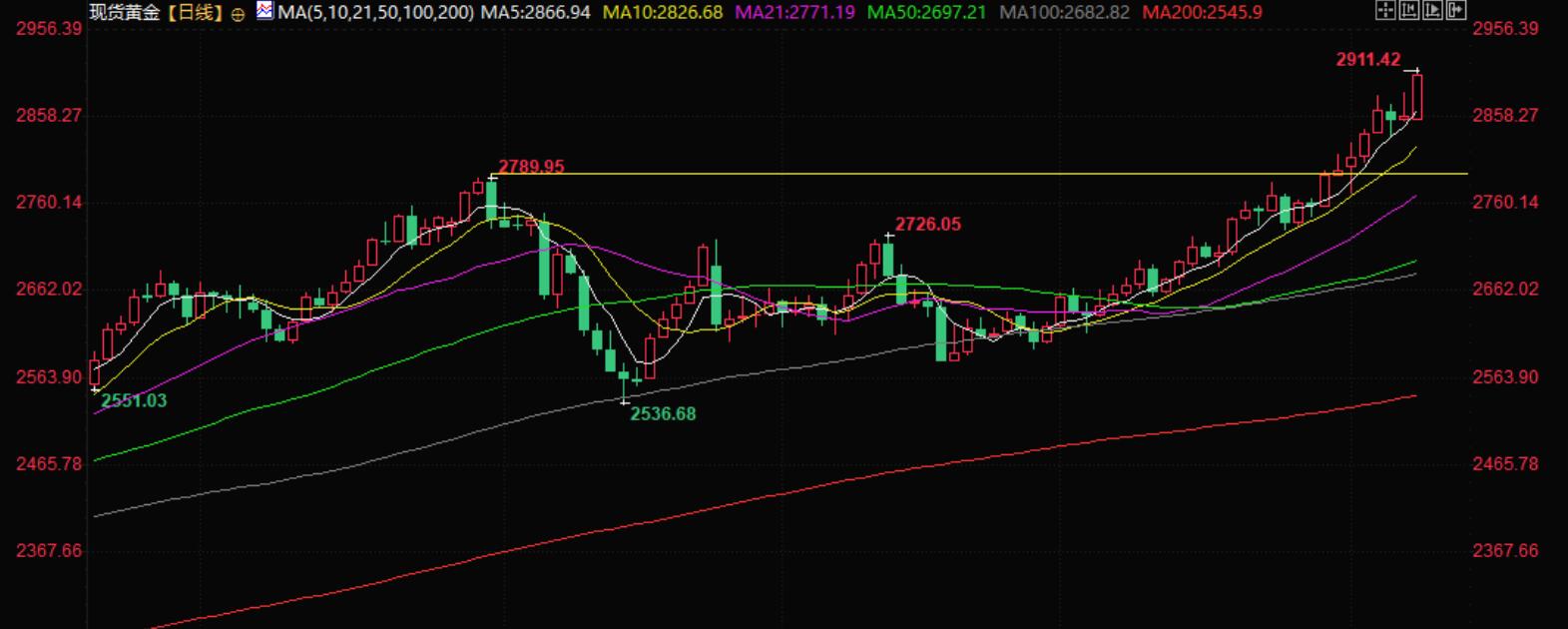Gold Trading Analysis: Gold Price Breaks $2900
On Monday (February 11th), gold prices continued their record high and broke through the key level of $2900 for the first time, reaching a high of $2911.42 per ounce, once again breaking historical highs and closing at $2907.92 per ounce, an increase of about 1.6%. Driven by safe haven demand, US President Trump's new tariff threat has intensified trade war and inflation concerns.
On February 11th, a tumultuous wave swept through the political and economic circles in Washington. According to media reports, President Trump plans to sign two major tariff executive orders within 48 hours: first, imposing a 25% "metal defense tax" on all imported steel and aluminum materials, and second, launching a "mirror counterattack" plan against tariffs imposed by various countries. This long planned trade offensive is like a deep water bomb thrown at the global market, triggering emergency responses from various countries and causing hidden waves in the financial market.
According to insiders, US President Trump is expected to sign an executive order on tariffs later on Monday or Tuesday, which could increase the risk of a multilateral trade war.
On February 9th, Trump announced that he would impose an additional 25% tariff on all steel and aluminum imports into the United States on top of existing tariffs. Later this week, he will also announce a series of further reciprocal tariffs, which has drawn retaliatory warnings from trading partners.
The sword of tariffs unsheathed
The new steel tariff policy will create a "tariff superposition effect" and build a high wall on the basis of the current tariff. According to data from the American Iron and Steel Institute, the United States will import over 25 million tons of steel in 2023, with Canada (25%), Brazil, and Mexico accounting for half of the total. What is even more striking is the pattern of primary aluminum imports - Canada holds a 79% market share with its advantage in hydropower. After the policy announcement, stocks of US steel and aluminum manufacturers rose, while stocks of European and Asian steel manufacturers fell.
Global Defense Front
The international community quickly formed an "anti customs union": the European Commission pointed out that the New Deal was "unjustifiable" and urgently arranged an interview between President von der Leyen and Vice President Vance of the United States at the AI Summit in Paris; The South Korean Ministry of Industry convened overnight meetings with companies such as Hyundai Steel to discuss countermeasures; Australia is playing the "defense and security card", emphasizing that its steel supports the joint defense system between the United States and Australia. Of particular note is that Japan's acquisition of US steel company by Nippon Steel has encountered political attacks, forcing Japan to consider a "strategic retreat".
Trade War 2.0 Upgrade
The Trump team is simultaneously advancing the "equivalent tariff" nuclear weapon: they plan to raise the EU car tariff from 2.5% to an equivalent level of 10%, and maintain the pickup truck tariff at 25% to form an asymmetric advantage. According to WTO data, the current average tariff of 2.2% in the United States may seem moderate, but "precision strikes" targeting specific goods are more lethal. In order to ease the situation, India has issued a signal to reduce taxes before the Modi Trump summit, attempting to resolve the "12% high tariff barrier" dilemma accused by the US.
Financial shock wave prediction
This metal tariff storm may trigger a triple impact: the US dollar index may rise first and then fall - initially volatile and rising due to the pursuit of safe haven funds, but with retaliatory tariffs weakening export competitiveness, the market may give up its gains in the future. The gold price is facing a dual benefit: the geopolitical trade risk premium combined with manufacturing costs is pushing up inflation expectations, and London gold is expected to break through $3000 per ounce. The more profound impact lies in the restructuring of the global supply chain, and multinational corporations may accelerate "nearshore outsourcing", promoting the resonance and upward trend of precious metals between industrial and financial attributes.
Marex analyst Edward Meir said, "Obviously, the tariff war is the reason behind the rise; it just reflects more uncertainty and tension in the global trade situation
Follow the future market
Tariffs may exacerbate inflation in the United States, and investors are waiting for the release of US Consumer Price Index (CPI) and Producer Price Index (PPI) data later this week.
Meir said that if CPI and PPI data are lower than expected, it could hit the US dollar and push up gold prices, while higher than expected could push up US Treasury yields and put pressure on gold, although this pressure will be mild due to market resilience and interest in buying at low levels.
Federal Reserve Chairman Powell will testify in Congress on Tuesday and Wednesday. On Tuesday, Federal Reserve Chairman Powell attended a Senate hearing and released his semi annual policy report, which investors need to pay close attention to; Additionally, pay attention to the speech delivered by New York Fed President Williams.

Daily chart of spot gold
Tips:This page came from Internet, which is not standing for FXCUE opinions of this website.
Statement:Contact us if the content violates the law or your rights
